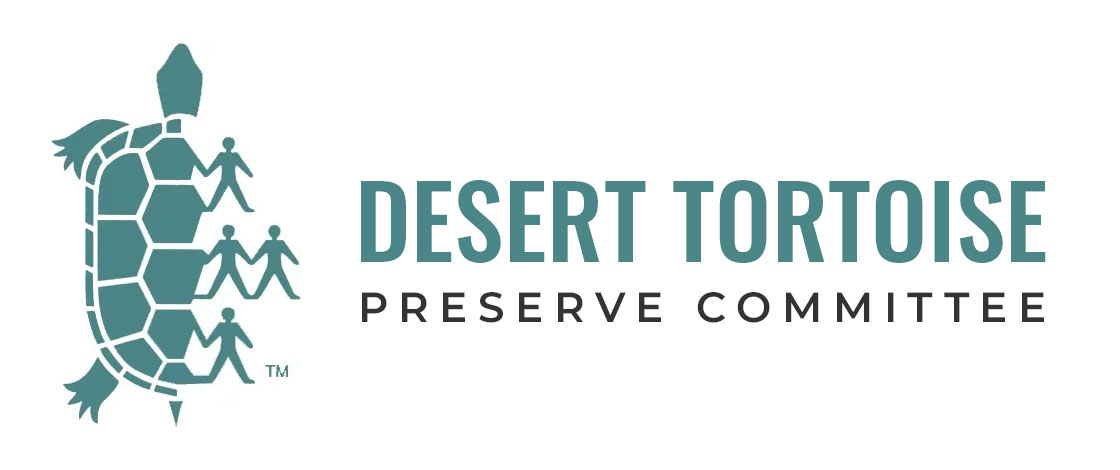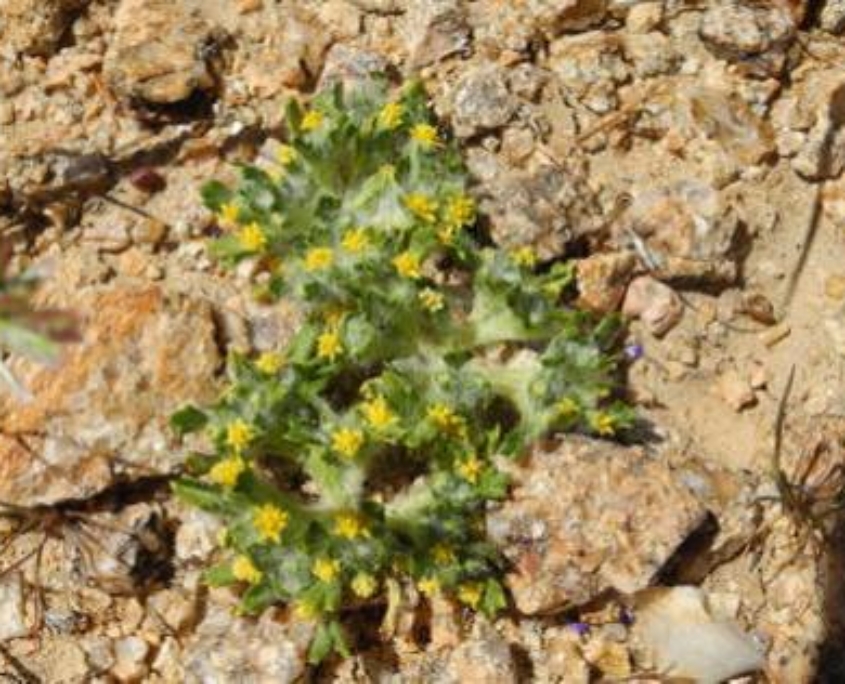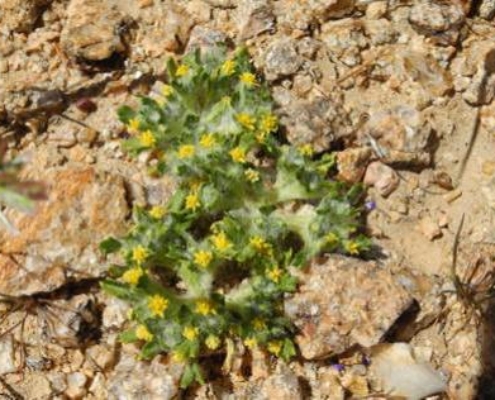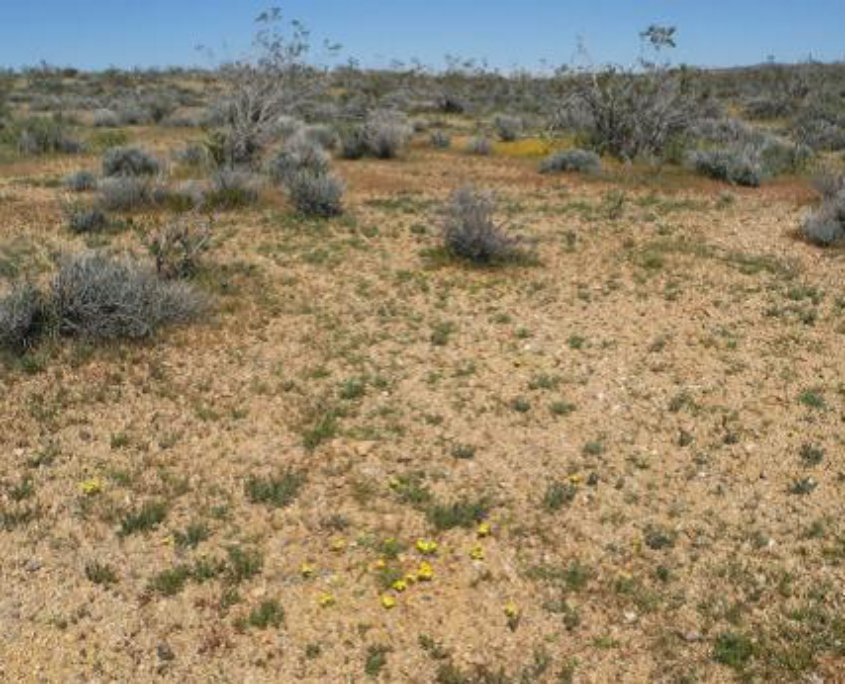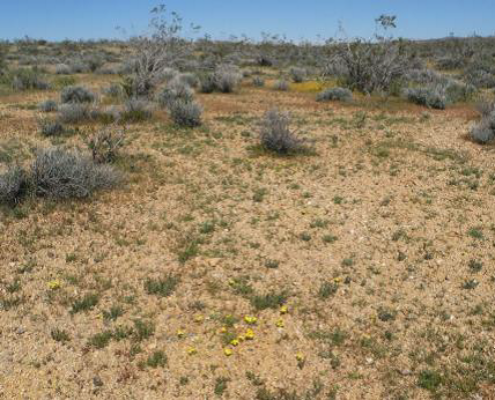Eriophyllum mohavense
Article and Photos by Denise LaBerteaux
Talk about being at the right place at the right time! On April 5 of this year, Pat Seamount and I set out to begin the first of five plant transects at the Desert Tortoise Research Natural Area. This work was being conducted for the USGS on one of Dr. Kristin Berry’s projects. I was navigating out to the transect located in the southern portion of Section 2 and was a bit off-course. My less than direct route took us directly to a small population of Barstow woolly sunflower (Eriophyllum mohavense) in the northeastern portion of Section 11. Plants were in full bloom. I knew immediately its identity, having surveyed for this species on several projects in the West Mojave. Populations are known from the vicinity of Barstow to a few miles east of Mojave and from Cuddeback Dry Lake to the Red Buttes.
The Barstow woolly sunflower is a California endemic and is a CNPS List 1B plant, a plant that is rare, threatened, or endangered in California. It occupies desert chenopod scrub, Mojavean desert scrub, and desert playas, occurring mostly in open, silty or sandy areas, barren ridges, or margins of playas between 1640 ft and 2952 ft in elevation.
We found 30-40 plants on a gentle, south-facing slope. They occurred on an undisturbed, shrubless patch of coarse gravel and pebbles within a creosote – white bur-sage scrub habitat. The soil particles were somewhat cemented together. Other annuals growing with the Barstow woolly sunflower included red-stemmed filaree (Erodium cicutarium), winged-nutted combseed (Pectocarya heterocarpa), Fremont gold (Syntrichopappus fremontii), and Mediterranean schismus (Schismus barbatus).
We did a quick search of the immediate area, snapped a few photos, GPS’ed the site, made a small collection, and then continued with our main objective for the day, conducting plant transects. That evening I emailed Dr. Berry about my find. She was very excited and made plans to come out to search additional areas for this plant.
On April 14 (a fabulous day, about 68 to 70 degrees, and NO WIND), Laura Stockton and Clyde Golden (CNPS) joined Kristin Berry, Ashley Emerson, and Heather Schneider (USGS) in searching for additional sites for the woolly sunflower. They walked north along the eastern section line of Section 11 almost to the ridge, then west to look at my site of initial discovery. Kristin found another site uphill of my site. Laura and Clyde left then (about 2:00 p.m.), and Kristin, Ashley and Heather continued to look and found another five sites to the west, north, and south. All sites were in similar habitat, associated with rises on low hills, and were in very small areas devoid of shrubs or where live or dead shrubs were scarce and where the ground was covered with small rocks about 0.5 to 2 inches in length. The topographic map indicates the sites were between 2940 and 2960 ft. Kristin also made a very small collection after they had found additional sites.
On April 20, Kristin and Mary Kotschwar (new DTPC Preserve Manager) went to search again for additional sites. First, they revisited one of the previous sites and the plants were still there, further along, and drying. The day grew cold and very windy. They covered the northeast portion of Section 11 and the southern 1/2th of the SE1/4 of Section 2, drifting a bit into Section 1, finding zero. Absolutely zero new sites with 5.5 hrs of search effort. The soil types for all 7 sites (including the initial site) were about the same; the annuals were similar to identical and the locations were very close to one another. There were other similar sites, drier in appearance, with nothing.
We will prepare the appropriate forms with photos and will discuss sending the voucher specimens to Rancho Santa Ana Botanic Garden and preparing records to send to the California Natural Diversity Database.
